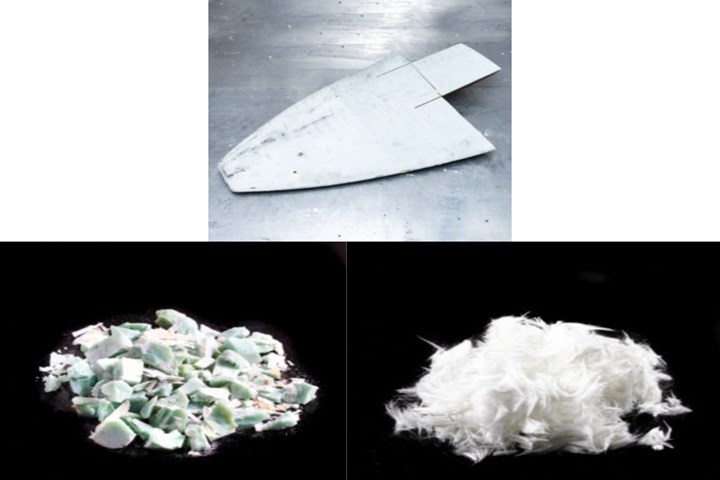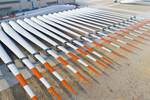UT receives funding for wind turbine blades recycling technology
The university is developing a large-scale glass fiber composite recycling system as an end-of-life (EoL) solution for wind blades.

(Top) wind blade tip; (left bottom) shredded material; (right bottom) recovered fiber glass. Photo Credit: University of Tennessee
It was reported on August 13 that, the University of Tennessee (UT) received $1.1 million in funding from the Department of Energy’s (DOE) Small Business Technology Transfer (STTR) program and Wind Energy Technologies Office. With this funding, the university is now developing a new technology for the large-scale recycling of wind turbine blades into new recycled composites.
According to UT, the technology recovers the glass fiber from reinforced polymer composites while limiting mechanical degradation of the fiber during the reclamation process. This in turn is said to allow the recycled fiber to be reused in new composite applications such as vehicle lightweighting, other renewable energy systems components and performance sports equipment.
“It’s not a mystery why wind energy is now America’s largest domestic source of renewable energy,” says Ryan Ginder, research assistant professor in UT’s Department of Mechanical, Aerospace and Biomedical Engineering and lead researcher on the project. “Wind power is clean, economical and readily available right here in the U.S., but it still has a problem; to make those giant iconic blades, wind turbine manufacturers rely on advanced polymer composites. These materials can survive some of mother nature’s most brutal forces but, eventually, do wear out and end up in the landfill. As the wind industry grows and waste blade levels climb into the tens, hundreds of thousands of tons and beyond, a better end-of-life (EoL) solution is needed rather than simply piling them at the dump.”
While the U.S. wind industry has made substantial contributions to America’s renewable energy portfolio says UT — as highlighted by American Wind Week 2020 put on by the American Wind Energy Association (AWEA) that was celebrated in mid-August — work remains ongoing to convert the industry to a more circular economy paradigm.
“Rather than simply downcycling the blades into worthless aggregates, we are able to not only convert the blades’ organic components into useful petrochemicals for energy production, but also able to extract the glass fiber reinforcement and use it to make higher value recycled composites,” says Ginder.
UT notes that it has partnered with Carbon Rivers LLC (Knoxville, Tenn., U.S.), a start-up company owned by UT alumnus Bowie Benson, to further develop and commercialize the novel glass fiber recovery technology for the purpose of handling retired wind turbine blades.
Over the next two years, the UT-Carbon Rivers team will be collaborating with GE Renewable Energy (Fairfield, Conn., U.S.), Berkshire Hathaway Energy’s MidAmerican Energy Company (Des Moines, Iowa, U.S.) and PacifiCorp (Portland, Oreg., U.S.) utilities to develop a pilot scale glass fiber composite recycling system that will serve as the basis for eventual deployment of a full-scale commercial wind blade waste processing plant.
Related Content
-
We4Ce infused 2.5-3-MW rotor blade design passes validation test
Composite rotor blade structure design by We4Ce, mold and prototype production by InDutch Composites and fatigue testing by Suzlon Group has resulted in the novel blade’s IEC61400-5:2020 certification.
-
SRI develops scalable, infiltration-free ceramic matrix composites
Work in two DOE projects is demonstrating C/C-SiC produced in 3-5 days with <5% shrinkage, <10% porosity and 50% the cost of conventional C/C and C/C-SiC.
-
Polar Technology develops innovative solutions for hydrogen storage
Conformable “Hydrogen in a Box” prototype for compressed gas storage has been tested to 350 and 700 bar, liquid hydrogen storage is being evaluated.
















